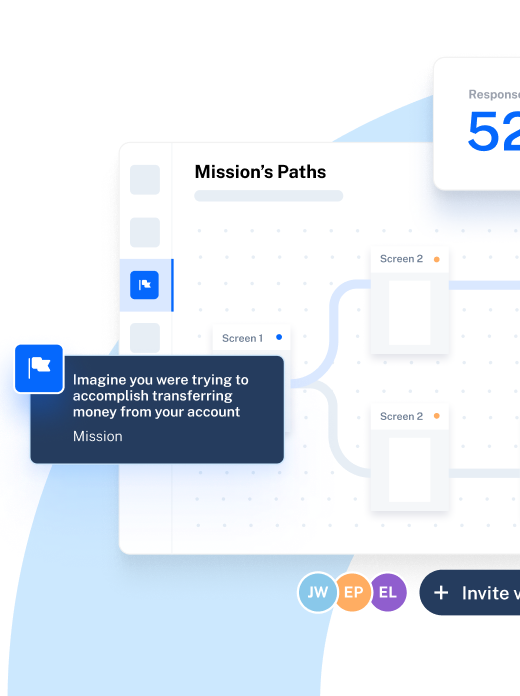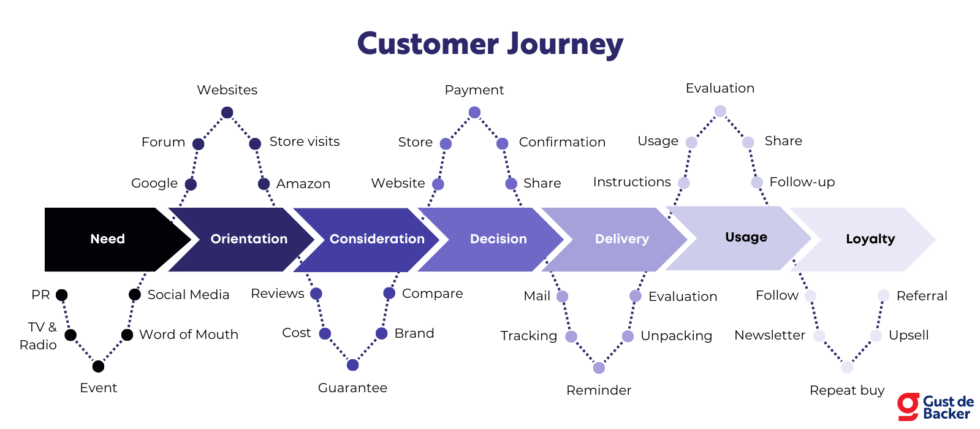Memorable customer experiences (CX) are seldom happy accidents. They’re the product of well-defined, well-executed customer experience strategies.
It’s not just about a great product or intuitive features, or excellent customer support teams—it's the whole journey, starting from the moment new customers first discover your product and ending, well, never. Because even if a customer leaves, your customer experience strategy should include a process for winning them back.
Providing a positive customer experience requires each little step of the customer journey to be continuously analyzed and optimized. Your CX strategy is what guides this.
In this article, you’ll learn how to create customer experience strategies built around the six pillars of successful customer experience, all grounded in expert-led best practices.
Let’s go.
Customer experience strategy: Why you need one
A customer experience strategy is a comprehensive plan for managing and improving the way customers interact with your product and brand throughout their entire customer journey. It provides structure and actionable guidance on improving all customer touchpoints for a consistent, seamless, and positive experience.
Think of your CX strategy as a blueprint, laying out every interaction a customer has with your brand, from initial discovery to post-purchase support. Creating a customer experience strategy helps you identify and hone in on all those points, to create a friction-free experience with your product and brand.
But customer experience strategies go beyond identifying touchpoints and mapping out the user experience. They also define specific customer experience metrics so you can measure your success in providing the best experience for your customers.
Do you need a customer experience strategy?
The short answer is yes. Stick with us for the longer answer…
A customer experience strategy helps provide a structured approach to CX, and is a comprehensive way to map out areas of improvement for your brand. CX strategies provide some crucial benefits, such as:
- Consistent and high-quality experience across major touchpoints: Ensure all your customer's needs are met as smoothly as possible, wherever they interact with your brand
- Increased customer satisfaction: Help identify actionable ways to win loyal customers, keep them happy, and improve customer retention
- Reduced customer churn: Minimize churn by monitoring how users perceive your brand and understanding how to encourage future interactions
- Data-driven insights for consistent improvement: Easily define how and when you’ll get feedback from customers to optimize their user experience
A customer experience strategy is the guiding landmarks towards a better customer experience. Like setting off on a roadtrip without a course in mind—you can certainly operate a business without a CX strategy, but your likelihood of success is significantly higher (and your journey will be a lot smoother!) with a map to guide you.
But before you dive in head-first, there are a few foundations every successful customer experience strategy should keep in mind.
What are the pillars of the customer experience?
There are a few key elements customers look for in every interaction with a product and brand. Prioritize these six pillars in your strategy, and you’ll be far better positioned to start building exceptional customer experiences.
1. Personalization: Create tailor-made experiences
Every customer relationship is different. A superior customer experience means acknowledging the unique needs of users and tailoring their individual user experience to provide personalized interactions and services. Accommodating customer preferences makes for a more engaging, relevant and thoughtful experience.
2. Time and effort: Make customer interactions a breeze
Streamlining processes and minimizing effort make for a more convenient customer experience. Optimizing these touchpoints makes it easy for customers to get what they’re after sooner, with minimal effort. Think things like simplifying user interface (UI) navigation, reducing form-filling, and providing quick and efficient customer service.
3. Expectations: Set expectations, then exceed them
Managing, meeting, and exceeding customer expectations is a crucial part of the customer experience. If you say you’re going to do something, do it. Overpromising is tempting, but any initial advantages gained from doing so are quickly outweighed by the disadvantages of not delivering. Customers value transparency when it comes to what they can expect from you—give it to them.
4. Integrity: Build trust through relevant touchpoints
Customers want to buy from brands they trust have their best interests at heart. Prioritizing transparency and honesty in your customer experience is crucial for CS success. Customers don’t want to feel like they’re being spun a story or patronized at any touchpoint along their customer journey—whether that’s when perusing your pricing page, speaking to a sales rep, or inputting their personal data.
5. Resolution: Solve customer complaints swiftly
Even with a relatively smooth customer experience, you’re bound to get complaints from customers. Swift and efficient resolution of these complaints minimizes their negative impact on the overall customer experience—and even has the potential to turn a bad experience into a good one.
6. Empathy: Keep customer concerns in mind
Understanding your customers’ feelings, seeing the journey from their perspective, and showing genuine concern for their needs translates to a positive customer experience. Doing so not only helps customers feel at ease while navigating their journey but also forms a bond and basis for trust—leading to greater customer loyalty. Friendly communication, responding to feelings of frustration, and flexibility are all ways to demonstrate that you care about customer experience.
Building up a customer experience strategy with these pillars in mind allows you to put your customer’s needs front and center. It gives you a structured approach to managing the customer experience, and ensures your strategy remained grounded in providing the best experience possible.
How to build a great customer experience strategy
Now you know the fundamental principles of great customer experiences, we’re ready to move on to building your strategy from scratch.
Here’s the main steps to create effective customer experience strategies.
1. Define your goals and metrics for success
Like most successful frameworks, creating a CX strategy begins with defining relevant goals and metrics for success. This step sets the direction for your entire strategy, and you’ll most likely find yourself returning to it to gauge progress.
You might choose to have a single, overarching business goal for your customer success strategy, like ‘improve all customer satisfaction metrics by 20%’, or you may prefer to break your strategy down into specific objectives based around individual metrics.
Whatever you choose, a crucial consideration is how you’ll evaluate success. Without customer experience metrics and KPIs, you can’t measure the success of your initiatives. Some popular customer experience metrics include net promoter score, customer satisfaction score, customer effort score, and more.
The key is making your goals measurable and manageable. If you’re struggling to define the goal of customer experience strategy, consider the SMART framework:
- Specific: Be specific about your point of your goal
- Measurable: Include a measurable aspect to evaluate success
- Achievable: Don’t set goals that are unrealistic
- Relevant: Ensure the goal supports and aligns your overarching UX strategy
- Time-bound: Set a time period for achieving this goal
2. Map the customer journey and key touchpoints
With your goal in mind, you’re ready to take a peek at the journey your customer undertakes while interacting with your brand. Here, you’re mapping out your customer’s journey and key touchpoints of interaction from the moment they start considering your product, to once they become a user and beyond.
Journey mapping is a tried-and-tested techniques for most CX and UX teams, where you map out a visualization of the every customer interaction with your product and brand. Typically, this consists of seven stages:
- Need
- Research
- Consideration
- Decision
- Delivery
- Useage
- Renewal
The broad structure of customer journey maps remains the same, but the names of these stages can vary depending on your business and product—for example, if you have a yearly subscription fee, you might change ‘loyalty’ to ‘renewal’. Or if you offer free trials, you could switch out ‘consideration’ to reflect this.
Using a customer journey map helps you focus on what matters and identify the key steps of a customer’s experience; allowing you to better identify relevant pain points and areas for to consider optimizing.
3. Outline your research operations and methods
Once you know how customers move through their experience with your product and brand, you can identify what needs optimizing to provide an unmatched customer experience and outline a plan to improve their journey.
Start by defining your UX research process and the relevant UX research methods—common techniques for customer research include UX surveys, interviews, and usability tests. These methods help you better pinpoint the exact areas of improvement for your brand, and provide data from real users to inform decision-making throughout the process.
Pro tip 💡 Now’s the time to speak to your research operations team if you have one, to ensure any customer research is organized, scalable, and reflective of wider research practices in your org.
Let’s say that one of the goals of your customer experience strategy is ‘receive 10% fewer negative customer reviews year on year’. By conducting user research, you’ll be able to identify pain points and issues that customers are experiencing. You can then resolve them to improve the customer experience and limit the number of negative reviews you receive.
Whether it’s working with your customer success team or conducting regular customer experience surveys; having a clear process for collecting and actioning customer feedback is a crucial part of building a robust CX.
4. Create supporting documentation
It’s not just about you knowing the ins and outs of your customer experience strategy— everyone in your organization needs to be able to access and understand your customer experience strategy. Along with journey maps, some especially handy documents to include are:
- Research repository: Once you conduct UX research, you’ll want to save data insight reports to look back on and take relevant insights to stakeholders
- Persona profiles: Refreshing or creating user personas from scratch helps you better understand your users and how you can improve their experience while using your product
- Implementation strategies: A narrative overview explaining exactly how you’re working to improve experiences ensures everyone is on the same page when putting the strategy into practice
- Experience vision standards and guidelines: Consider what your customer experience vision looks like—once you identify needed improvements, detailed guidelines that outline best practices and what ‘good’ looks like will ensure experience consistency and quality
5. Get everyone on board
The customer experience involves your entire organization. It’s not just customer success and support, or the product team designing and shipping features, but everyone on the team. Building a CX strategy and putting it into play requires getting everyone up to speed on the game plan.
It’s about ensuring all the stakeholders, from leadership to front-line employees, understand and are committed to improving customer experience. This step should involve internal communications, team meetings, and training sessions to convey the strategy’s importance, get stakeholder buy-in, and evangelize the research you’re doing to build a better CX.
It’s only when everyone is on board that your customer experience strategy can start to take effect. There’s little point having one team who understands and acts on the strategy, when you’ve got another that has no clue. It’s a team effort—there’s no two ways about it.
6. Implement your strategy
Congrats, you’re ready to start optimizing the customer experience with your customer experience strategy. You’ve made the plans and rallied the team, now all that’s left is to begin working on customer experience initiatives.
Optimizing the customer experience is by no means a ‘one and done’ approach—it’s a continuous cycle of researching, optimizing, and evaluating. There are many aspects of the customer experience, and you need to improve all of them to elevate your customer experience as a whole.
Your customer experience strategy is the light that guides you. It’s how you ensure you’re on the right path, and not aimlessly making changes and adjustments without knowing why or what you’re working towards.
3 Top tips for building a successful CX strategy
Ever heard the phrase “nothing worth having comes easy”?
Building a customer experience strategy can be tricky due to the complex and expansive nature of customer experiences. To help you on your way, we’ve compiled five expert-led CX strategy best practices to help you build the best CX strategy possible.
1. Be comprehensive, but not confusing
When creating a CX strategy, you want to be as comprehensive as possible. However, you need to be careful that this doesn’t become confusing.
You’ll be returning to your strategy time and time again to inform decision-making, as will other team members—who may know less about your customers and strategy than you. CX strategies should be simple enough to be easily understood and implemented by everyone.
Haley Stracher, CEO and Design Director at Iris Design Collaborative, explains how to keep it informative yet straightforward:
“Explain everything! Assume your team knows nothing about your CX strategy or what you’re asking them to do.
“Remember that explaining doesn’t mean using a bunch of text—you can explain through graphic visuals, guided walkthroughs, and just plainly keeping each process incredibly simple so people aren’t overwhelmed with lots of information all at once.”
2. Track the right KPIs
Focusing on optimizing CX requires you to measure your strategy’s success along the way. Without qualitative and quantitative customer data, it’s easy to get lost in processes and lose sight of what you’re trying to accomplish.
KPIs not only give you a benchmark for success but act as a compass for focused campaigns and design improvements for the whole strategy. They provide clarity on what works and what doesn't.
One of the easiest ways to measure customer experience KPIs is through use of rating scales and surveys that can quickly quantify your CX results. Some KPIs to watch include:
- Customer satisfaction score: Typically obtained through a survey with rating scales, the CSAT score measures how satisfied customers are with your company and service
- Net promoter score: NPS scores are all about measuring customer loyalty and how likely customers are to recommend your service to others
- Customer effort score: CES tells you how easy or difficult it is for customers to use your product or service across one or multiple touchpoints
- Conversion rates: These metrics help you understand how many customers complete a desired action set by your company such as making a purchase, filling out a form, or clicking a link
Remember to always choose the appropriate KPIs by circling back to the main goal of your CX strategy. Haley gives her thoughts on KPIs in evaluating the customer experience:
“I think all metrics have some worth, but it’s about looking at the whole picture. Are you comparing apples to oranges? Or are you comparing apples to apples? Make sure you know when to step back and look at the entire flow, and when to zoom in and focus on one single step.”
While KPIs are definitely helpful, calculating them manually can be time-intensive. Using the right tool can help you streamline your process and save valuable time better spent on improving customer experience. Which leads us to number three…
3. Leverage the right tech to act on your strategy
Masterfully creating a successful customer experience strategy is a time-consuming commitment, but there’s a ton of tech and tools available to help you.
To effectively implement your customer experience strategy, UX research tools can help collect customer feedback with a suite of research methods, including interviews, surveys, and usability tests. Tools with AI features that can automate feedback analysis are also valuable time-savers, uncovering trends and customer insights in a matter of minutes.
Using the right tool can help bring your CX strategy to life. Whether it’s tools that help conduct user research, streamline product management, or improve the payment process—the right techstack helps facilitate a great customer experience.
Bring your CX strategy to life with Maze
A thorough customer experience strategy ensures decision-making aligns with your ultimate goal of meeting (and exceeding) customer expectations. It’s how you guarantee the entire organization is aligned on what’s expected of CX, and what you’re working towards.
There’s many steps in optimizing the customer experience, but none of it is possible without the backbone of user research. Whether you want to check in on NPS scores, understand why users abandon mid sign-up, or test for usability issues—Maze is a comprehensive platform that lets you turn customer feedback into actionable insights.
Frequently asked questions about customer experience strategy
What are the components of a customer experience strategy?
What are the components of a customer experience strategy?
The components of a customer experience strategy are brand, product, price, and service. Your CX strategy should provide guidance and goals on all these aspects to be comprehensive.
What is a customer experience framework?
What is a customer experience framework?
A customer experience framework is a structured approach and roadmap that outlines the specific elements and processes that are involved in managing customer experience.
What is a customer experience vision statement?
What is a customer experience vision statement?
A customer experience vision statement is a short description of the ideal experience a company aims to provide for customers. It serves as a guiding experience for all customer experience efforts and decisions and helps you build customer-centric products.
What is the difference between CX vs. UX?
What is the difference between CX vs. UX?
While Customer Experience (CX) and User Experience (UX) are related, and similar in many ways, they holds separate principles, goals, and purposes.
- UX is specifically about how a user experiences your product when using it, which may be impacted by factors like usability or UI/UX design
- CX covers the entire customer journey, from when they first discover your product to post-purchase






